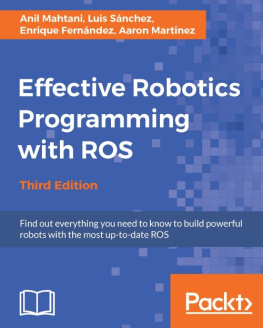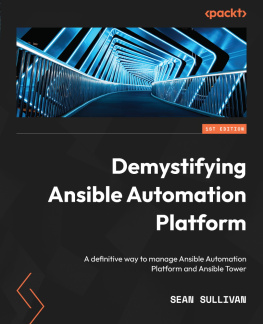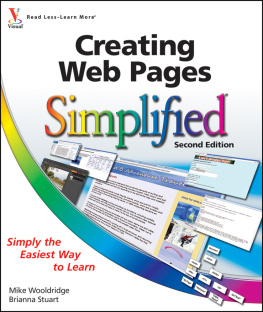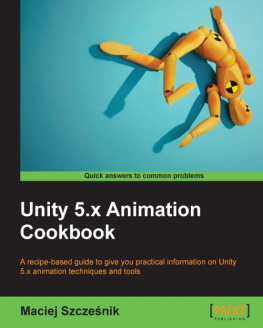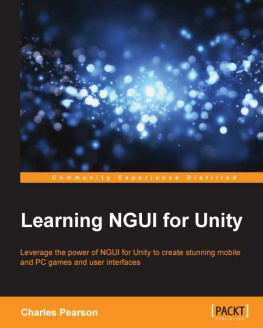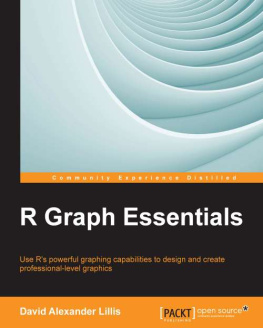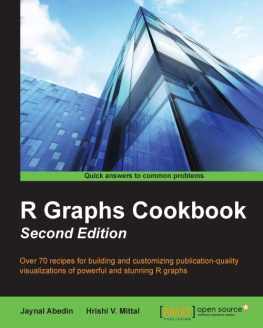Shantanu N. Zagade
Shantanu N. Zagade
About the Authors
Anil Mahtani is a computer scientist who has dedicated an important part of his career to underwater robotics. He first started working in the field with his master thesis, where he developed a software architecture for a low-cost ROV. During the development of his thesis, he also became the team leader and lead developer of AVORA, a team of university students that designed and developed an autonomous underwater vehicle for the Students Autonomous Underwater Challenge Europe (SAUC-E) in 2012. That same year, Anil Mahtani completed his thesis and his MSc in Computer Science at the University of Las Palmas de Gran Canaria and then became a Software Engineer at SeeByte Ltd, a world leader in smart software solutions for underwater systems. In 2015, he joined Dell Secureworks as a Software Engineer, where he applies his knowledge and skills toward developing intrusion detection and prevention systems.
During his time at SeeByte Ltd, Anil Mahtani played a key role in the development of several semi-autonomous and autonomous underwater systems for the military and oil and gas industries. In those projects, he was heavily involved in the development of autonomy systems, the design of distributed software architectures, and low-level software development and also contributed in providing Computer Vision solutions for front-looking sonar imagery. At SeeByte Ltd, he also achieved the position of project manager, managing a team of engineers developing and maintaining the internal core C++ libraries.
His professional interests lie mainly in software engineering, algorithms, data structures, distributed systems, networks, and operating systems. Anil's main role in robotics is to provide efficient and robust software solutions, addressing not only the current problems at hand but also foreseeing future problems or possible enhancements. Given his experience, he is also an asset when dealing with Computer Vision, machine learning, or control problems. Anil has also interests in DIY and electronics, and he has developed several Arduino libraries, which he has contributed back to the community.
First of all, I would like to thank my family and friends for their support and for always being there when I needed them. I would also like to thank my girlfriend Alex for her support and patience, and for being a constant source of inspiration. Finally, I would like to thank my colleagues Ihor Bilyy and Dan Good, who have taught me a lot, both personally and professionally, during these new steps in my career as a software engineer.
Luis Snchez has completed his dual master's degree in electronics and telecommunication engineering at the University of Las Palmas de Gran Canaria.
He has collaborated with different research groups as the Institute for Technological Development and Innovation (IDETIC), the Oceanic Platform of Canary Islands (PLOCAN), and the Institute of Applied Microelectronics (IUMA) where he actually researches on imaging super-resolution algorithms.
His professional interests lie in Computer Vision, signal processing, and electronic design applied on robotics systems. For this reason, he joined the AVORA team, a group of young engineers and students working on the development of Underwater Autonomous Vehicles (AUV) from scratch. Inside this project, Luis has started developing acoustic and Computer Vision systems, extracting information from different sensors such as hydrophones, sonar, or camera.
With a strong background gained in marine technology, Luis cofounded Subsea Mechatronics, a young start-up, where he works on developing remotely operated and autonomous vehicles for underwater environments.
Here's what Dario Sosa Cabrera, a marine technologies engineer and entrepreneur (and the cofounder and maker of LPA Fabrika: Gran Canaria Maker Space) has to say about Luis:
"He is very enthusiastic and an engineer in multiple disciplines. He is responsible for his work. He can manage himself and can take up responsibilities as a team leader, as demonstrated at the euRathlon competition. His background in electronics and telecommunications allows him to cover a wide range of expertise from signal processing and software, to electronic design and fabrication."
Luis has participated as a technical reviewer of the previous version of Learning ROS for Robotics Programming and as a cowriter of the second edition.
First, I have to acknowledge Aaron, Anil, and Enrique for inviting me to participate in this book. It has been a pleasure to return to work with them. Also, I want to thank the Subsea Mechatronics team for the great experience working with heavy underwater robots, we grew together during these years. I have to mention LPA Fabrika Gran Canaria Maker Space for the enthusiasm preparing and teaching educational robotics and technological projects; sharing a workspace with kids can be really motivating.
Finally, I will have to thank my family and my girlfriend for the big support and encouragement in every project where I'm involved. I want to dedicate my contribution in this book to them.
Enrique Fernndez has a PhD in computer engineering and an extensive background in robotics. His PhD thesis addressed the problem of Path Planning for Autonomous Underwater Gliders, but he also worked on other robotics projects, including SLAM, perception, vision, and control. During his doctorate, he joined the Center of Underwater Robotics Research in the University of Girona, where he developed Visual SLAM and INS modules in ROS for Autonomous Underwater Vehicles (AUVs), and participated in the Student Autonomous Underwater Challenge, Europe (SAUC-E) in 2012, and collaborated in the 2013 edition; in 2012, he was awarded a prize.

